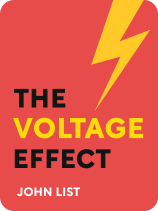

This article is an excerpt from the Shortform book guide to "The Voltage Effect" by John A. List. Shortform has the world's best summaries and analyses of books you should be reading.
Like this article? Sign up for a free trial here.
Should you pay bonuses before or after the performance period? What’s the best way to use social incentives within a team?
In The Voltage Effect, economist and professor John A. List offers his advice for how to take things from the small scale to the big stage. He shares a set of strategies designed to increase your business’s chances of success as it grows. One of these is using reward-based motivation.
Read more to learn how to scale successfully by setting the right incentives to motivate your team.
Reward-Based Motivation
List argues that reward-based motivation is a more effective focus than leadership style or personality when it comes to managing your workforce at scale. It’s better to focus on incentives than leadership style because talented individuals don’t scale, making it impossible to replicate the unique qualities of gifted leaders across your organization. However, incentives are much more easily scaled as blanket policies across your organization.
(Shortform note: While List fervently advocates workplace incentives, other authors have argued that incentives have little to no effect on employee performance. These authors argue that, at best, incentives cause employees to briefly attempt to change their behavior before reverting to their prior patterns. According to this school of thought, incentives actually distract employees from the work itself. Incentives lead employees to view the work as an obstacle they must overcome to earn a bonus, which leads them to lose interest in the work altogether.)
List recommends taking advantage of loss aversion when setting incentives. According to List, people are generally more motivated by their fear of loss than by their desire to gain. To take advantage of this element of human nature, pay out performance bonuses for a given period of time before the period begins, letting employees know that they’ll have to repay the bonus if they don’t hit their targets. When employees get the incentive up front, they’ll be more motivated to work hard to keep it, thanks to loss aversion.
For example, suppose you’re a parent, trying to motivate your 16-year-old to work harder in school. To get them to study, you could offer them an incentive based on their interests—this could be a new videogame, new clothes, or anything else they’re interested in. To take advantage of loss aversion, you’d want to give your kid their reward at the beginning of the semester, and let them know that they’ll only be allowed to keep it if they dedicate a certain amount of time to studying or achieve a certain grade. Based on List’s principle, your child will work harder to protect the reward they’ve already been given than they would to earn a potential future reward.
(Shortform note: According to List, incentives that use loss aversion are more powerful than traditional bonuses. However, in some studies, loss aversion incentives produced an unexpected decrease in workplace productivity. Researchers believe that when employees are presented with loss aversion incentives, they become more incentivized to avoid loss than to pursue success. For example, a salesperson who was presented with loss aversion incentives might adopt a conservative strategy, focusing on not blowing sales calls, instead of focusing on closing them.)
According to List, social incentives can also be powerful motivational tools. Workplace social dynamics can impact performance. Social incentives make use of the interpersonal factors that motivate your employees. Specifically, List notes that people tend to work harder when they know that their performance is being monitored, in a phenomenon known as the Hawthorne effect. By letting your employees know that you’re tracking their performance, giving them clear targets, and offering them encouragement, you can take advantage of the Hawthorne effect to get the best out of your workforce.
For example, suppose you’re the manager of the sales department at an insurance company, and you want to use the Hawthorne effect to encourage your staff to make an extra effort. A simple way to do this would be to set and communicate goals for each employee, and then let your staff know that you’ll be checking in regularly on their progress toward those goals. Thanks to this gentle nudge (using the Hawthorne effect), you’d likely see a bump in productivity.
| Does the Hawthorne Effect Exist? List’s proposed social incentives rest on the assumption that the Hawthorne effect is a near-universal phenomenon. However, there is still significant disagreement within the scientific community about whether the Hawthorne effect even exists. Some researchers have argued that in the study in which the effect was first described, there was insufficient evidence to infer a causal relationship between observation and behavioral change. According to a meta-analysis of the literature on the Hawthorne effect, while many studies demonstrate some evidence for the effect’s existence, most studies of the Hawthorne effect contained methodological inconsistencies that may have compromised their results. These findings suggest that further research is necessary to concretely establish the existence of the Hawthorne effect. |

———End of Preview———
Like what you just read? Read the rest of the world's best book summary and analysis of John A. List's "The Voltage Effect" at Shortform.
Here's what you'll find in our full The Voltage Effect summary:
- How to take ideas from the small scale to the big stage
- The red flags that signal you may have trouble scaling up
- Strategies designed to increase your idea’s chances of success






